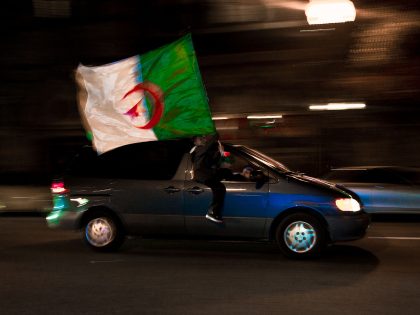The Slave Ship Theme
The Cape Town company that designs and markets "slave ship" ironing boards and aprons.

The ironing board in question. Image from the Facebook page.
What is it with some white South Africans’ penchant for living in an a-historical bubble? Gumtree, the South African Craigslist, is running an ad for an apartment in Randburg, a former white suburb of Johannesburg (with about 30% black residents) to which only “young white professionals” are invited to apply; then people who should know better (journalists, researchers), think Apartheid wasn’t so bad after all. Now there’s a Cape Town company that–in the name of subversive “art”–designs products using a slave ship drawing from a 1788 abolitionist anti-slavery pamphlet (chances are you’ve seen it). Yes: a graphic of a slave ship packed with slaves, intended to depict the inhumanity of chattel slavery, is now printed on dresses, aprons and ironing boards (which they actually refer to as “slaving boards”).
Maid in Africa (a white-owned company in–where else?–Cape Town, South Africa) is a design studio run by a couple, Micha and Andrew Weir. They “convert fine art into utility objects.” The slave ship themed ironing/slaving board is intended evoke the ethos of the company: “Ebony & Irony, Aloe Africana and Boerewors on a Roll.” Their brand slogan for this particular range of products is “Slave to Fashion.” Why are they doing this? Because, according to their PR, “15 million African people displaced during the slave trade left a permanent imprint on the continent’s fabric.”
The idea (design and premise) to put the slave slip on an ironing board is taken wholesale from a piece called ‘Stowage’ by the African-American artist Willie Cole in which he interprets the shape of an ironing board to be the shape of, possibly, a slave ship. That piece (which looks identical to the Weirs “design”), was exhibited at MoMA and other major galleries, and received a lot of critical attention.
As Africa is a Country contributor, T.O. Molefe. pointed out on Facebook:
Cole’s inspiration is that of a black artist reflecting on his own ancestry and the lived experiences of his mother and aunts. It’s a deeply personal reflection for him and thus a highly original concept, despite its origins in a historical image. These things in my view suggest that Cole’s treatment of The Brookes Ship has, since 1997, when he made the ship into an ironing board, filtered through news, word of mouth and in other ways to eventually end up as a Maid in Africa print stripped of its original context.
If you have time, go check out the comments on their Facebook page (as well as this thread), and see the Weirs defend their stupidity as some sort of antiracist activism. They are also condescending to their critics.
The moneymaker here is a combination of transgressive hipsterism with a reminder to powerful consumers that not only are they safe in their positions of power, but that they are “helping.” (They trace their origins to helping to create work for a domestic worker who lost her job when her employees moved to Canada.)
What do the company’s owners say? On a Facebook post, where Molefe had a discussion thread going, Micha Weir jumped in and offered the following explanation:
[The drawing] came to epitomize the cruelties of the trade in enslaved Africans of the 18th and 19th centuries and the struggle to abolish that trade. Our intention by printing it on an everyday utility item, an ironing board, was to bring the fact of slavery closer to home …. It is a statement against denial and the moral high grounds attempt to white wash a society where the poor still slave for the rich. Our greedy consumer behaviour enslaves millions of people every day all over the world by buying designer t-shirts made in sweatshops, drinking Coke, consuming shit at MacDonald’s or flaunting our wealth at Woolworths. We are all “Slaves to Fashion”, enslaved by banks, trend setters or pure consumerism.
That’s rich.
So, when I buy some junk because the Kardashians say I should, am I in the same position as someone forced to wear a mouth bit, shacked to the floor of a ship for months? Or if I buy the stuff the Weirs have made (stuff I don’t need), I become more conscious of how my consumer habits help create indentured labour?
Who was it that said, recently, on Twitter “I hate it when people want to make a point by comparing x, y, z to either slavery or the Holocaust”? Yeah. That’s just the beginning of the point we want to make. Second, you just forced (the symbolic) bodies of people who already did the labour of creating your privilege to continue to do the labor of creating pathos and pity. Third, in South Africa, who will be actually using that ironing board, looking at a historical representation of enslaved labourers? Not the madam who should be getting conscientized. We wouldn’t put it past certain madams to actually buy such a ironing board cover, only to have their R100 ($10) a day plus lunch “domestic” spend the day in meditation over how their position in history hasn’t changed a whole hell of a lot. (BTW, the label for the ironing board says “Hand wash in cold water (or ask the maid)”.)
On Facebook Molefe argued,
I really wish you [the Weirs] did not assume people objecting to your use of it were doing so from a place of ignorance to art history or the purpose of art. Even if some are, there are a genuine issues of making light of and money off of other people’s experiences that saying “but it’s art!” does not answer. If your intention is to question slavery and the domestication of black bodies with this print, and as a response the people whose lived experiences are of slavery and domestication are objecting, then you are doing it all wrong and clearly not listening.
You’d think all this would be obvious (hello, Weirs, black people are on the Internet and read art history). Then to make things worse, they still had a stall at Cape Town’s annual Design Indaba. (This, BTW, is also an important part of the story: how a major design festival thinks it is okay to sanction and legitimize this.) Word is there was a petition to have them removed from the Indaba, but it seems they showed anyway as this picture taken by artist Athi-Patra Ruga shows:
This being Cape Town and South Africa,the Weirs and Maid in Africa have no shortage of defenders. (They already do on the company’s Facebook page). There’s also a few others doing this kind of thing. Maid in Africa’s postcards, featuring shack-designs (no royalties there, either, it seems safe to assume), are marketed as a “celebration of free enterprise and free-range chicken,” and recall a similar stunt by Woolworths–the national retailer aimed at middle class shoppers of the tacky Mandela tribute.
A few aisles away from that shop’s Israeli tomatoes and the organic meats, you can buy Shack Box Soap. Yes, soap packaged to look like informal housing. One of the designers on Behance.com describes it as a “soap project that embraces the culture of South African Townships. Exploring the vibrant colours and juxtaposition of material to re-create a township experience.” Because, as someone commented on Facebook, nothing says ‘township experience’ like paying R50 (about $5 US) for a bar of soap.
Nice. These free enterprise models sure remind me of another group of people who took shit from some other people without asking and said they now owned it. Note to Maid in Africa: the people who actually came up with those shack designs might really celebrate if you gave them the percentage owed for appropriating and profiting from their intellectual property and design skills. Business partnerships: that’s real help. But putting an historical image of slaves on an ironing board (or on your dress) and commodifying pity isn’t.
Really people. We can’t anymore.



















